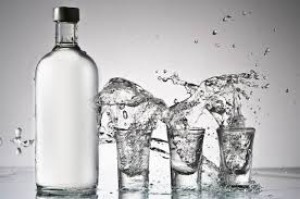What not to eat with thick blood — nutrition rules and 12 prohibited foods
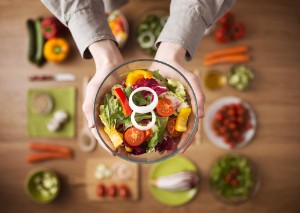 Too thick blood in humans is a serious problem not only of the circulatory, but also of the cardiovascular, as well as other systems in the body.
Too thick blood in humans is a serious problem not only of the circulatory, but also of the cardiovascular, as well as other systems in the body.
Blood thickening entails a violation of nutrition and oxygen supply to all organs and can lead to the most severe consequences. Therefore, when such a pathology is detected, doctors prescribe anticoagulants to patients — pharmaceutical diluents.
But the daily menu in this case also needs to be adjusted. Because According to scientific research , through nutrition, cholesterol levels can be lowered and the risk of developing many cardiovascular diseases can be reduced.
In addition, at the initial stage of the development of many diseases, the blood composition can be significantly improved by observing the regime and rules of a healthy diet. In this article, we will look at what you need to eat to reduce blood viscosity. We will discuss the rules of the diet for too thick blood, as well as prohibited and permitted foods.
Content
3 general diet rules
Anyone over the age of 40 and those who have been officially diagnosed with increased blood clotting, it is necessary to learn that constant dieting is the only possible way to preserve the health of both men and women. It will no longer be possible to maintain a normal state of health only by taking pharmacy medications.
But the rules of nutrition for increased blood clotting and high cholesterol are not complicated. feeling good will be a good incentive to constantly lead a proper lifestyle.
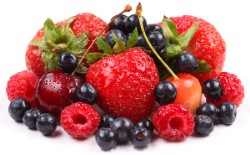
- Building a diet based on plant foods. A large amount of vegetables ensures the supply of fluids, vitamins, minerals and fiber to the body, all of which the blood cannot have a normal clotting level without. A list of 15 Blood thinning vegetables , you will find it in a separate article. Fruits and berries are useful for the same reasons.
- Reducing the amount of animal fats consumed. Animal fat, which did not go to the construction of tissues in the body and does not participate in the functional activity of certain types of cells, is not absorbed by organs from the circulatory system, but clogs it and is deposited on the inner walls of blood vessels, impeding blood flow. That's why, for example, dairy products thicken the blood .
- Exclusion of low-quality and harmful food. Fast food, snacks such as chips, lemonades of industrial production do not carry any nutritional value: they deliver nutritional pleasures, but they greatly harm the body, without bringing it any benefit. The composition of semi-finished products always includes a large number of preservatives, dyes, flavors, a lot of salt and low-quality ingredients that reduce the cost of production.
8 Healthy Blood Thinning Foods
There are a large number of foods that are allowed to be consumed with an increase in blood viscosity. Some of them even contribute to its reduction, that is, they act as natural anticoagulants.
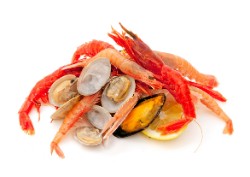
- Clean drinking water. It is absorbed as much as possible without disturbing the structure of the blood mass, unlike store-bought drinks or other liquids that clog the blood and lymph. Of course, you can also use vegetable broths, juices and homemade compotes. But in no case can they completely replace drinking water with them. Moreover, it must be of high quality, well-purified, so that this product benefits the blood and lymph, and does not clog them. Distilled water should not be drunk, preference should be given to pure spring water, filtered or mineral water without gas.
- Tomatoes . This vegetable is one of the few useful for blood in any form: fresh or heat—treated, in the form of sausages or winter snacks, in salads or in the form of juice and even tomato paste. Despite its sour taste, this vegetable does not acidify the internal environment: it converts its own acids into alkali, which cleans the vessels and dilutes the blood.
- Seafood. Fatty sea fish and seaweed are essential for blood. They supply the body with essential fatty acids and iodine, lower cholesterol levels and help maintain normal blood flow. Learn more about the effect of omega-3 on blood viscosity in a separate article.
- Unrefined vegetable oils, nuts and seeds. Sunflower, olive, pumpkin, nut butters, as well as peanuts, hazelnuts, flaxseed contain large amounts of vitamin E, taurine, arginine and unsaturated fatty acids Omega-3, Omega-6 and Omega-9. In addition to the fact that these substances are indispensable in the synthesis of tissues and the vital activity of many types of cells, they also purify blood and blood vessels, maintaining a normal level of viscosity and increasing blood flow.
- Low-fat dairy products. The minimum amount of animal fats is absolutely necessary for a living organism. In addition, proteins, minerals and vitamins are absorbed worse from completely low-fat dairy products. Low—fat butter is also, most likely, not butter, but margarine, which is harmful to health. Therefore, low-fat cottage cheese, kefir or butter "without cholesterol" are not considered useful. As well as too fat ones. But a small percentage of fat content will help in the assimilation of everything that is useful for the circulatory and other body systems.
- Sour berries and fruits. It is necessary to include in the diet such Blood thinning berries , like cherries, strawberries, gooseberries, black and red currants, cranberries, lingonberries, viburnum, blueberries, grapes. To fruits that reduce blood viscosity , lemons, tangerines, oranges and other fruits that contain ascorbic and salicylic acids can be attributed.
- Ginger. This spicy root vegetable has anti-inflammatory and cleansing properties, which affect, among other things, the quality of blood. Ginger makes blood less viscous , lowering the level of "bad" cholesterol, cleanses blood vessels, improving their patency and increasing blood flow.
- Honey. The main product of beekeeping has long been used as a healing agent that improves the structure and composition of blood, heals blood vessels and heart muscle. About the effect of honey on the blood see in a separate article.
Also pay attention to the table:
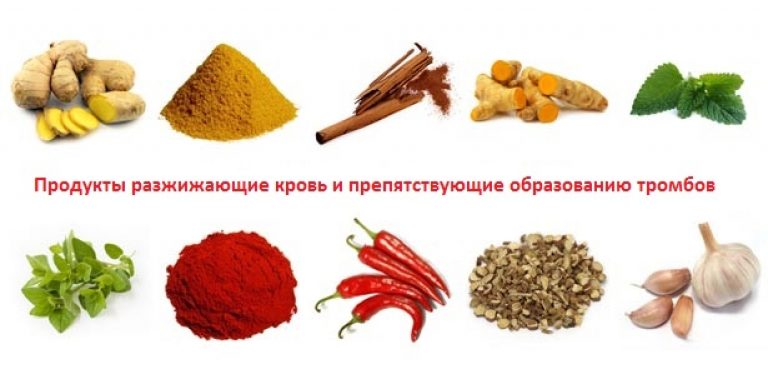
Neutral food
There are a number of products about which nutritionists are most often silent, talking about their effect on the blood. Sometimes you can find contradictory information about them. This is due to the complex composition of products, which includes substances that thicken blood and those elements that can dilute it.
With regard to such food, it is worth adhering to moderation and deciding whether to introduce them into the diet individually.
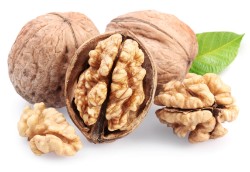
- Cereals. There is an unequivocal opinion about only one cereal: it is believed that it is worth abstaining from buckwheat with increased coagulability. The rest of the cereals do not have a pronounced property, so they can all be presented in a sufficient variety on the menu. A list of 5 blood-thinning cereals , you will find in a separate article.
- Pumpkin. This is a vegetable that is extremely useful for the circulatory and other body systems. But its flesh contains a lot of vitamin K, which can thicken the blood. At the same time, there is a large amount of fiber and structured water, which help to purify the blood substance and reduce clotting.
- Walnut. It is also advisable to solve the issue of its effect on the circulatory system on an individual basis. On the one hand, it contains arginine, vitamin E and other substances that help to reduce clotting, and on the other hand, many nutritionists call it a means of combating reduced clotting.
12 prohibited products
It is undesirable to consume a small range of foods in large quantities if a person has a tendency to blood clots, varicose veins and thrombosis. And some products are strictly prohibited, because they either have a strong thickening property, or contribute to increased clotting and do not bring any benefit to the human body. So, what can not be eaten with increased blood density:

- Buckwheat. Buckwheat should not be excluded from the diet completely, as it is a very useful cereal. But you should not use it every day in the form of cereals, side dishes and as part of the first courses: this will lead to increased clotting.
- Banana. Bananas are good for the cardiovascular system , including for improving blood composition. But if a banana prevails in the menu of a person prone to thrombosis, then it will not do him any harm.
- Chokeberry. Mountain ash cleanses blood vessels and is useful for elderly people diagnosed with hypertension. It contains a large amount of vitamins. But vitamin K will increase clotting, so even with high blood pressure and atherosclerosis, chokeberry can not always be consumed fearlessly.
- Fatty pork, mutton, lard. Unlike previous products, fatty meat and lard should be completely excluded from the diet of the elderly and those diagnosed with increased clotting, despite the fact that these are natural and healthy products for many. Excess cholesterol will definitely increase the viscosity of the blood mass.
- Fried dishes and smoked foods. Carcinogens found in fried or smoked foods clog the entire body, including the circulatory system.
- Margarine and refined vegetable oils. Margarine is processed vegetable fats, sometimes with the addition of animals. This product does not carry any substances useful for the body, and the amount of cholesterol clogging the blood from it may be no less than from heat-treated fats of animal origin. Refined vegetable oil, although by its nature it cannot contain cholesterol, is not useful even for a healthy person: they add calories to food, having practically no nutritional value.
- Fatty dairy products. Fats from whole village milk, butter, sour cream, cream and other dairy products are useful for a teenager or a child who needs a large amount of fat for development and growth. But in the diet of a mature or blood-clotting person, such food should be extremely small, since it, like fatty meat, clogs the blood and increases its coagulability.
- Sausages and semi-finished meat products. There is much more fat in sausages and semi-finished meat products such as cutlets, raw minced meat, kupat, marinated meat for barbecue than it seems. In addition, flavor enhancers, preservatives, and dyes are usually added to them, which preserve the pink color and the external freshness of meat products. All this cannot but affect the composition of the blood. And with increased clotting, it is advisable to gradually abandon the habit of eating such food.
- Fast food. Dishes from fast-food establishments are prepared from low-quality products to reduce the cost, which is masked by ready-made sauces harmful in composition such as mayonnaise and low-grade ketchup. They contain harmful trans fats, a lot of salt and the same dietary supplements that are harmful not only to the digestive tract, but also to the whole body.
- White bread, muffins and pastries. In addition to high calorie content, products of this type, especially those prepared on an industrial scale, are distinguished by the same harmful ingredients as fast food. These are trans fats and food additives: flavorings, flavor enhancers, substances to enhance splendor, dyes, etc.
- Sweets based on refined sugar. Even homemade sweets are not useful for the circulatory system. And store-bought ones include so many substitutes that it is difficult to talk about any of their benefits at all, except for energy.
- Purchased juices and lemonades. Carbonated water has this feature: it dissolves more sugar in itself than regular drinking water. Therefore, carbonated drinks with sugar significantly harm the composition of the blood. But carbon dioxide enhances the effect, helping not only sucrose, but also foreign food additives to be absorbed faster. As for juices, they are far from a natural product in their composition: at best it is a fruit puree diluted with water, at worst it is a sweet mixture with harmful additives. The exception is tomato juice: they don't put a lot of sugar in it, and its beneficial properties are preserved, even if it is prepared by adding water to tomato paste.
Power mode
If there is a suspicion of increased blood density, you need to immediately start getting used to fractional nutrition.
As for the ratio of foods in the diet, the first place should be that which is rich in fiber, minerals and vitamins:
- Vegetables,
- Fruits,
- Herbs and spices.
Seafood, cereals and low—fat dairy products are on the second, low—fat meat is on the third.
Other important recommendations
To reduce clotting, it is necessary to acquire a number of useful habits. Only in this case it is possible to achieve a significant and stable improvement in well-being.

- Drinking clean drinking water in sufficient quantity. The blood substance for the most part consists of water, and when there is a shortage of it in the body, it is the circulatory system that suffers, which is forced to give fluid to other organs. Dehydration thickens the blood in the first place. Therefore, you need to drink an average of 1.5-2 liters of clean drinking water.
- The ratio of diet and medication intake. With a tendency to varicose veins and increased clotting, it is necessary to get used to consulting a doctor about the ratio of medications taken and the underlying foods. Since many products have a very strong diluent effect, this may not be useful when taken simultaneously with some anticoagulant medications.
- Active lifestyle. To improve blood circulation, it is important to move a lot. Hiking, swimming, and gymnastics are useful. But working with weights in the gym is prohibited. It is especially dangerous to overload the heart and blood vessels at the initial stage of healing, when there may be blood clots in the circulatory system.
It is also important to understand that too abrupt, rapid blood thinning is dangerous because undissolved clots can begin to move quickly through the bloodstream, which can lead to a stroke. Therefore, it is impossible to rush to change the density of blood.
Related videos
We offer to watch the video:
Conclusion
Increased clotting is fraught with the development of atherosclerosis, the occurrence of stroke or heart attack, as well as the aggravation of chronic diseases of other body systems. Therefore, it is important for any person to monitor their diet in order to prevent the development of this pathology of the circulatory system.




